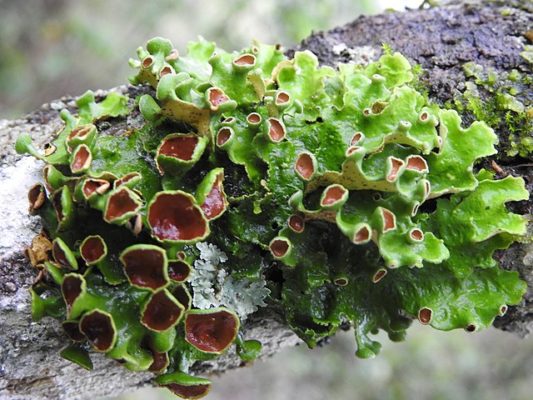Lichens may be the most easily overlooked life forms in nature. If you spend much time outside, you probably see some every day, although you might not know it – most people are likely to think they’re moss. However, lichens aren’t plants (which mosses are), but rather fungi that team up with algae and/or cyanobacteria to form a kind of composite organism. Although they rank relatively low on the biological charisma scale, lichens play important roles in ecological communities, from carbon uptake to food for a variety of animals, and they’re the quintessential example of symbiosis – a partnership between two separate organisms – and were even the subject of research that first proposed the concept of symbiosis in the late 1800s.
Symbioses are known across the natural world, and despite the key roles they play in structuring ecosystems, their origins, persistence and impact over evolutionary timescales is still not well understood by scientists. In a new study in Proceedings of the Natural Academy of Sciences, a team of researchers have advanced our understanding of the evolution of symbiosis by assembling the largest family tree of lichens to date, covering more than 3,300 species. They used this data to figure out how and when lichen fungi traded algae partners, and shifted between crusty and leafy/tufted growth forms over the past 250 million years, shedding new light on the ebb and flow of symbioses over evolutionary timescales. “These data allow us to better understand which symbiotic associations stick together or break apart and how their ecological contributions have shifted through time,” says lead author Matthew Nelsen, a researcher at Chicago’s Field Museum.
The researchers, from the Field Museum, Stanford University, and the Botanical Garden and Museum in Berlin, drew on a massive set of DNA sequence data to reconstruct an enormous family tree of the largest group of lichenized fungi—a group that exceeds birds in its total diversity. For each fungal species, they recorded which algae group it associates with and what it looks like (crusty, or leafy/tufted). They then used a technique called ancestral state reconstruction to infer which algae partner each ancestor was most likely to have associated with, and which growth form it likely produced. They also used the tree to calculate the rates at which new species arose and disappeared over time. “Since the record of fossils for lichens and fungi is very sparse, it is difficult to reconstruct their evolution from fossil evidence,” notes Robert Lücking of the Botanical Garden and Museum in Berlin. “This type of quantitative study based on DNA sequence data attempts to replace this gap by attempting to reconstruct the past from the present.”
Lichens are often thought of as primeval, but our comparisons reveal that diversification booms in the lichens came surprisingly late.
KEVIN BOYCE, Professor of Geological Sciences
Their findings revealed some turbulence early in the history of this group of fungi. It’s well-known that some fungi lost the ability to form lichens in the past, and switched to become decomposers or plant parasites, consistent with observations in many other symbioses. “What was unexpected,” Nelsen notes, “was how deep in the family tree this occurred—roughly 200 million years ago. Some of these descendants have continued to persist in a non-lichenized state, while others picked up another algae partner, in some cases at roughly the same time as other groups of non-lichenized fungi were evolving lichen associations with that same group of algae.” This broader trend coincided with the evolution of habitats favorable for these algae, such as wet tropical rainforests dominated by flowering plants. As Lücking observes, “as a specialist in tropical lichens, for me it is particularly fascinating to see how some chiefly tropical lineages switched from being lichenized and became decomposers and even parasitic fungi, and then in some cases eventually returned to a lichen habit.”
The scientists also wanted to see how these results related to other types of fungi. They compared their findings to a recent study focused on a diverse and well-known group of mushrooms, which are largely decomposer and root-symbiotic fungi. As co-author Kevin Boyce of Stanford notes, “lichens are often thought of as primeval, but our comparisons reveal that diversification booms in the lichens came surprisingly late. Mushrooms diversified rapidly during the Jurassic, while the lichens experienced a gradual increase in speciation and extinction from the mid-Cretaceous to the present, corresponding to a world increasingly dominated by flowering plants. Determining these conflicting patterns of evolution are the first step in understanding the broader environmental and evolutionary context.”
As Lücking suggests, the huge set of DNA data “provides a fascinating window into what lichen communities might have looked like in the distant past, how they evolved over time along with dinosaurs, and how they achieved their present diversity with the evolution of modern ecosystems.” Indeed, the evolutionary dynamics that played out with these fungi and partners in the deep past form the foundation of the symbioses we know today. “Symbiotic associations are everywhere, and they’re a fundamental force in evolution and in our environment,” Nelsen declares. “Since lichens are a classic model of symbiosis, understanding the ways they changed partners, shifted physical forms, and diversified over millions of years has broader insights for the deep processes of symbiosis itself.”
Read the paper: PNAS
Article source: Standford Earth
Image credit: Evaldo Resende/ Wikimedia






